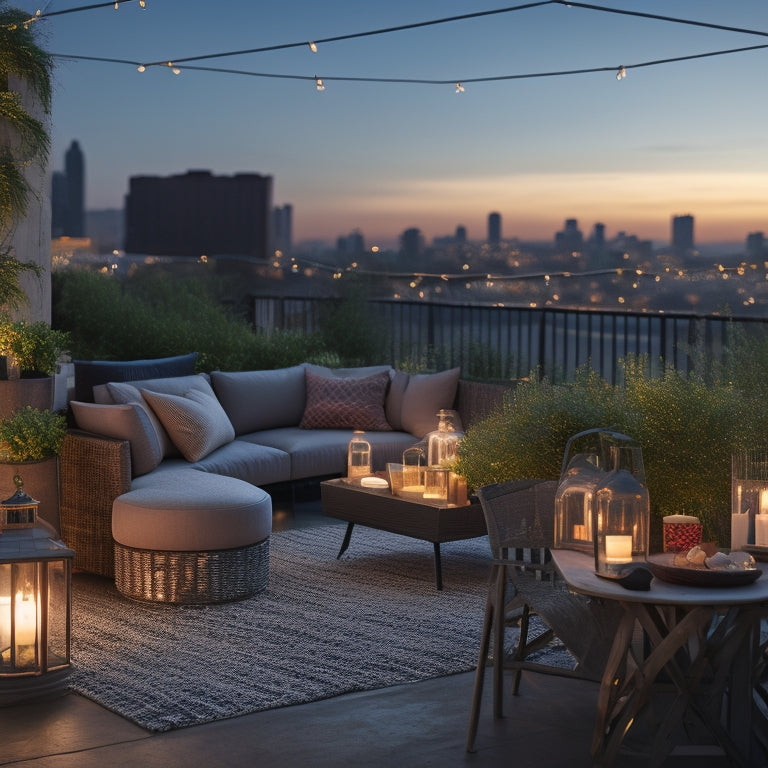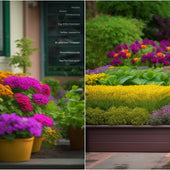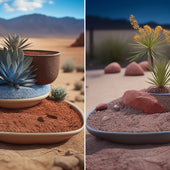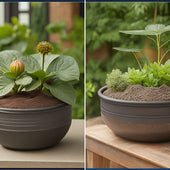
Illuminating Your Rooftop Oasis at Night
Share
When illuminating your rooftop oasis at night, you'll want to create an ambiance that invites relaxation and exploration. You can achieve this by incorporating soft lighting elements, like string lights and lantern arrangements, to create a cozy atmosphere. To draw attention to statement features, use spotlights and accent lights strategically. Don't forget to prioritize safety and visibility with pathway lighting and highlight potential hazards. With energy-efficient LED innovations and solar-powered lights, you can minimize your environmental footprint. By selecting the right color temperatures, you can evoke distinct moods and transform your rooftop oasis into a mesmerizing haven - and that's just the beginning of your nighttime oasis transformation.
Key Takeaways
• Incorporate soft lighting elements, like string lights and lanterns, to create a cozy ambiance in your rooftop oasis at night.
• Highlight focal points, such as statement art or water features, with spotlights and accent lights to draw attention and create visual interest.
• Ensure safety and visibility with layered lighting, pathway lights, and strategic lighting placement to minimize hazards and guide visitors.
• Opt for energy-efficient lighting solutions, such as solar-powered and LED lights, to reduce your environmental footprint and save energy.
• Use color temperatures strategically to evoke specific moods and create distinct zones within your rooftop oasis, from warm and relaxing to cool and energizing.
Soft Lighting for Ambiance
As you design your rooftop oasis, consider incorporating soft lighting elements that subtly wash the space with warm, gentle hues, instantly creating a cozy ambiance that invites relaxation and conversation.
To achieve this, string lights can be strategically placed to create a sense of intimacy and whimsy. You can hang them from trellises, gazebos, or even the rooftop's railing to create a soft, ethereal glow.
Alternatively, lantern arrangements can be used to add a touch of elegance and sophistication. Place them on tables, along walkways, or in corners to create pools of warm light that guide guests through the space. When selecting lanterns, opt for soft-shaded varieties that diffuse light, rather than harsh, direct lighting.
By incorporating these soft lighting elements, you'll create an inviting atmosphere that encourages guests to linger and enjoy the rooftop oasis.
Remember to balance lighting levels to avoid overwhelming the space, and don't be afraid to experiment with different lighting combinations to find the perfect ambiance for your rooftop retreat.
Highlighting Focal Points
You can draw attention to specific design elements, such as a statement piece of art, a water feature, or a lush green wall, by strategically positioning spotlights or accent lights to highlight these focal points, creating visual interest and guiding the eye through the rooftop oasis. This thoughtful focal point placement allows you to control the visual narrative of your outdoor space, emphasizing what you want to showcase and downplaying what you don't.
Here are some ideas to get you started:
| Focal Point | Lighting Fixtures | Placement Tips |
|---|---|---|
| Statement Art | Spotlights | Position above or beside the art to create dramatic shadows |
| Water Feature | Underwater Lights | Submerge lights in the water to create a mesmerizing glow |
| Lush Green Wall | Accent Lights | Place lights at the base of the wall to highlight texture and depth |
Safety and Visibility First
Frequently, rooftop oases require layered lighting to ascertain safety and visibility, especially in areas with stairs, seating, or other features that can pose tripping hazards.
As you design your rooftop oasis, you'll want to prioritize security measures to guarantee a safe and enjoyable experience for you and your guests. This is where pathway illumination comes in.
By installing pathway lights along walkways, stairs, and around seating areas, you'll create a clear and visible route for navigation, reducing the risk of accidents and injuries. These lights can be strategically placed to highlight potential hazards, such as changes in elevation or obstacles, and can also be used to create a warm and inviting ambiance.
When selecting pathway lights, consider using energy-efficient options with a high lumen output to provide maximum visibility. Additionally, look for lights with a durable design that can withstand outdoor conditions and require minimal maintenance.
Energy Efficiency in Mind
By opting for energy-efficient lighting solutions, you can illuminate your rooftop oasis while minimizing its environmental footprint and reducing your energy costs.
One way to achieve this is by harnessing natural energy from the sun through solar options. Solar-powered lights can be an excellent choice, as they're powered by photovoltaic cells that convert sunlight into electricity. This means you'll reduce your reliance on traditional energy sources and lower your carbon emissions.
Another approach is to leverage LED innovations, which offer significant energy savings compared to traditional lighting methods. LED lights use a fraction of the energy required by incandescent bulbs, making them an attractive option for eco-conscious homeowners. Additionally, LEDs have a longer lifespan, reducing the need for frequent replacements and waste.
Transforming With Color Temperatures
As rooftop oasis designers, selecting the ideal color temperature for your lighting scheme can dramatically alter the ambiance, functionality, and overall character of your outdoor space.
You'll want to evaluate the color psychology behind different temperatures to create the desired mood. Warm whites (2700K-3000K) evoke a cozy, relaxing atmosphere, perfect for lounging areas or dinner gatherings.
Cool whites (3500K-4100K) provide a neutral, energizing ambiance, ideal for task-oriented spaces like outdoor kitchens or bars. Blues and daylight whites (5000K-6500K) can stimulate and refresh, making them suitable for exercise or meditation areas.
By strategically incorporating different color temperatures, you can create distinct zones within your rooftop oasis, each tailored to a specific activity or mood.
By doing so, you'll not only enhance the aesthetic appeal of your space but also amplify the mood enhancement benefits of your lighting design.
With a thoughtful approach to color temperature, you'll be able to craft an immersive experience that harmonizes with your unique lifestyle and preferences.
Frequently Asked Questions
Can I Install Rooftop Lighting Myself or Hire a Professional?
You're wondering if you can tackle rooftop lighting installation solo or should hire a pro. While DIY installation might save bucks, it's essential to weigh the risks of electrical mishaps and compromised structural integrity against the benefits of professional services.
How Do I Protect My Rooftop Lighting From Harsh Weather Conditions?
When selecting rooftop lighting, you'll want to prioritize weatherproof materials and assess lighting durability to guarantee your fixtures can withstand harsh conditions. Look for IP-rated and UL-listed products, and consider using corrosion-resistant materials like stainless steel or aluminum.
Are There Any Specific Building Codes for Rooftop Lighting I Should Know?
You'll need to guarantee building code compliance by researching rooftop lighting regulations in your area, as they vary by region, to avoid costly rework and guarantee your oasis shines safely and legally.
Can I Use Solar-Powered Lights for My Rooftop Oasis?
You're wondering if solar-powered lights are an option, and the answer is yes! You'll reap solar light benefits, like energy efficiency, by harnessing the sun's power to illuminate your space, all while reducing your carbon footprint.
How Often Should I Replace or Clean My Rooftop Lighting Fixtures?
You'll need to replace or clean your rooftop lighting fixtures regularly to maintain their performance. Typically, fixtures last 5-7 years, but you should inspect and clean them every 6-12 months to guarantee ideal function and extend their lifespan.
Related Posts
-

Optimal Soil Ph for Planter Boxes Made Easy
You need to optimize your planter box's soil pH to create a thriving environment for your plants, as the ideal pH ran...
-

Optimal Soil Ph for Planter Boxes Made Easy
You need to optimize your planter box's soil pH to create a thriving environment for your plants, as the ideal pH ran...
-

Optimal Soil Ph for Planter Boxes Made Easy
You need to optimize your planter box's soil pH to create a thriving environment for your plants, as the ideal pH ran...
-

Optimal Soil Ph for Planter Boxes Made Easy
You need to optimize your planter box's soil pH to create a thriving environment for your plants, as the ideal pH ran...
-

Optimal Soil Ph for Planter Boxes Made Easy
You need to optimize your planter box's soil pH to create a thriving environment for your plants, as the ideal pH ran...
-

Optimal Soil Ph for Planter Boxes Made Easy
You need to optimize your planter box's soil pH to create a thriving environment for your plants, as the ideal pH ran...
-

Optimal Soil Ph for Planter Boxes Made Easy
You need to optimize your planter box's soil pH to create a thriving environment for your plants, as the ideal pH ran...
-

Optimal Soil Ph for Planter Boxes Made Easy
You need to optimize your planter box's soil pH to create a thriving environment for your plants, as the ideal pH ran...
-

Optimal Soil Ph for Planter Boxes Made Easy
You need to optimize your planter box's soil pH to create a thriving environment for your plants, as the ideal pH ran...
-

Optimal Soil Ph for Planter Boxes Made Easy
You need to optimize your planter box's soil pH to create a thriving environment for your plants, as the ideal pH ran...
-

Optimal Soil Ph for Planter Boxes Made Easy
You need to optimize your planter box's soil pH to create a thriving environment for your plants, as the ideal pH ran...
-

Optimal Soil Ph for Planter Boxes Made Easy
You need to optimize your planter box's soil pH to create a thriving environment for your plants, as the ideal pH ran...
-

Optimal Soil Ph for Planter Boxes Made Easy
You need to optimize your planter box's soil pH to create a thriving environment for your plants, as the ideal pH ran...
-

Optimal Soil Ph for Planter Boxes Made Easy
You need to optimize your planter box's soil pH to create a thriving environment for your plants, as the ideal pH ran...
-

Optimal Soil Ph for Planter Boxes Made Easy
You need to optimize your planter box's soil pH to create a thriving environment for your plants, as the ideal pH ran...
-

Optimal Soil Ph for Planter Boxes Made Easy
You need to optimize your planter box's soil pH to create a thriving environment for your plants, as the ideal pH ran...
-

Optimal Soil Ph for Planter Boxes Made Easy
You need to optimize your planter box's soil pH to create a thriving environment for your plants, as the ideal pH ran...
-

Optimal Soil Ph for Planter Boxes Made Easy
You need to optimize your planter box's soil pH to create a thriving environment for your plants, as the ideal pH ran...
-

Optimal Soil Ph for Planter Boxes Made Easy
You need to optimize your planter box's soil pH to create a thriving environment for your plants, as the ideal pH ran...
-

Optimal Soil Ph for Planter Boxes Made Easy
You need to optimize your planter box's soil pH to create a thriving environment for your plants, as the ideal pH ran...
-

Optimal Soil Ph for Planter Boxes Made Easy
You need to optimize your planter box's soil pH to create a thriving environment for your plants, as the ideal pH ran...
-

Optimal Soil Ph for Planter Boxes Made Easy
You need to optimize your planter box's soil pH to create a thriving environment for your plants, as the ideal pH ran...
-

Optimal Soil Ph for Planter Boxes Made Easy
You need to optimize your planter box's soil pH to create a thriving environment for your plants, as the ideal pH ran...
-

Optimal Soil Ph for Planter Boxes Made Easy
You need to optimize your planter box's soil pH to create a thriving environment for your plants, as the ideal pH ran...
-

Optimal Soil Ph for Planter Boxes Made Easy
You need to optimize your planter box's soil pH to create a thriving environment for your plants, as the ideal pH ran...
-

Optimal Soil Ph for Planter Boxes Made Easy
You need to optimize your planter box's soil pH to create a thriving environment for your plants, as the ideal pH ran...
-

Preventing Soil Settlement in DIY Planters
To prevent soil settlement in your DIY planters, you'll want to focus on selecting a well-balanced soil mix with good...
-

Preventing Soil Settlement in DIY Planters
To prevent soil settlement in your DIY planters, you'll want to focus on selecting a well-balanced soil mix with good...
-

Preventing Soil Settlement in DIY Planters
To prevent soil settlement in your DIY planters, you'll want to focus on selecting a well-balanced soil mix with good...
-

Preventing Soil Settlement in DIY Planters
To prevent soil settlement in your DIY planters, you'll want to focus on selecting a well-balanced soil mix with good...
-

Preventing Soil Settlement in DIY Planters
To prevent soil settlement in your DIY planters, you'll want to focus on selecting a well-balanced soil mix with good...
-

Preventing Soil Settlement in DIY Planters
To prevent soil settlement in your DIY planters, you'll want to focus on selecting a well-balanced soil mix with good...
-

Preventing Soil Settlement in DIY Planters
To prevent soil settlement in your DIY planters, you'll want to focus on selecting a well-balanced soil mix with good...
-

Preventing Soil Settlement in DIY Planters
To prevent soil settlement in your DIY planters, you'll want to focus on selecting a well-balanced soil mix with good...
-

Preventing Soil Settlement in DIY Planters
To prevent soil settlement in your DIY planters, you'll want to focus on selecting a well-balanced soil mix with good...
-

Preventing Soil Settlement in DIY Planters
To prevent soil settlement in your DIY planters, you'll want to focus on selecting a well-balanced soil mix with good...
-

Preventing Soil Settlement in DIY Planters
To prevent soil settlement in your DIY planters, you'll want to focus on selecting a well-balanced soil mix with good...
-

Preventing Soil Settlement in DIY Planters
To prevent soil settlement in your DIY planters, you'll want to focus on selecting a well-balanced soil mix with good...
-

Preventing Soil Settlement in DIY Planters
To prevent soil settlement in your DIY planters, you'll want to focus on selecting a well-balanced soil mix with good...
-

Preventing Soil Settlement in DIY Planters
To prevent soil settlement in your DIY planters, you'll want to focus on selecting a well-balanced soil mix with good...
-

Preventing Soil Settlement in DIY Planters
To prevent soil settlement in your DIY planters, you'll want to focus on selecting a well-balanced soil mix with good...
-

Preventing Soil Settlement in DIY Planters
To prevent soil settlement in your DIY planters, you'll want to focus on selecting a well-balanced soil mix with good...
-

Preventing Soil Settlement in DIY Planters
To prevent soil settlement in your DIY planters, you'll want to focus on selecting a well-balanced soil mix with good...
-

Preventing Soil Settlement in DIY Planters
To prevent soil settlement in your DIY planters, you'll want to focus on selecting a well-balanced soil mix with good...
-

Preventing Soil Settlement in DIY Planters
To prevent soil settlement in your DIY planters, you'll want to focus on selecting a well-balanced soil mix with good...
-

Preventing Soil Settlement in DIY Planters
To prevent soil settlement in your DIY planters, you'll want to focus on selecting a well-balanced soil mix with good...
-

Preventing Soil Settlement in DIY Planters
To prevent soil settlement in your DIY planters, you'll want to focus on selecting a well-balanced soil mix with good...
-

Preventing Soil Settlement in DIY Planters
To prevent soil settlement in your DIY planters, you'll want to focus on selecting a well-balanced soil mix with good...
-

Preventing Soil Settlement in DIY Planters
To prevent soil settlement in your DIY planters, you'll want to focus on selecting a well-balanced soil mix with good...
-

Preventing Soil Settlement in DIY Planters
To prevent soil settlement in your DIY planters, you'll want to focus on selecting a well-balanced soil mix with good...
-

What Depth Is Best for My Planter
When selecting a planter, consider the root depth requirements of your chosen plant species, as this dictates the min...
-

What Depth Is Best for My Planter
When selecting a planter, consider the root depth requirements of your chosen plant species, as this dictates the min...
-

What Depth Is Best for My Planter
When selecting a planter, consider the root depth requirements of your chosen plant species, as this dictates the min...
-

What Depth Is Best for My Planter
When selecting a planter, consider the root depth requirements of your chosen plant species, as this dictates the min...
-

What Depth Is Best for My Planter
When selecting a planter, consider the root depth requirements of your chosen plant species, as this dictates the min...
-

What Depth Is Best for My Planter
When selecting a planter, consider the root depth requirements of your chosen plant species, as this dictates the min...
-

What Depth Is Best for My Planter
When selecting a planter, consider the root depth requirements of your chosen plant species, as this dictates the min...
-

What Depth Is Best for My Planter
When selecting a planter, consider the root depth requirements of your chosen plant species, as this dictates the min...
-

What Depth Is Best for My Planter
When selecting a planter, consider the root depth requirements of your chosen plant species, as this dictates the min...
-

What Depth Is Best for My Planter
When selecting a planter, consider the root depth requirements of your chosen plant species, as this dictates the min...
-

What Depth Is Best for My Planter
When selecting a planter, consider the root depth requirements of your chosen plant species, as this dictates the min...
-

What Depth Is Best for My Planter
When selecting a planter, consider the root depth requirements of your chosen plant species, as this dictates the min...
-

What Depth Is Best for My Planter
When selecting a planter, consider the root depth requirements of your chosen plant species, as this dictates the min...
-

What Depth Is Best for My Planter
When selecting a planter, consider the root depth requirements of your chosen plant species, as this dictates the min...
-

What Depth Is Best for My Planter
When selecting a planter, consider the root depth requirements of your chosen plant species, as this dictates the min...
-

What Depth Is Best for My Planter
When selecting a planter, consider the root depth requirements of your chosen plant species, as this dictates the min...
-

What Depth Is Best for My Planter
When selecting a planter, consider the root depth requirements of your chosen plant species, as this dictates the min...
-

What Depth Is Best for My Planter
When selecting a planter, consider the root depth requirements of your chosen plant species, as this dictates the min...
-

What Depth Is Best for My Planter
When selecting a planter, consider the root depth requirements of your chosen plant species, as this dictates the min...
-

What Depth Is Best for My Planter
When selecting a planter, consider the root depth requirements of your chosen plant species, as this dictates the min...
-

What Depth Is Best for My Planter
When selecting a planter, consider the root depth requirements of your chosen plant species, as this dictates the min...


